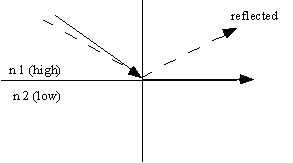
III. Refractive Index (n)
Refractive Index (n) is an important diagnostic
optical property of a mineral. It is defined as the ratio of the speed of light
in a vacuum to its speed in the mineral, or n = C/Cm, where C is the speed of
light in vacuum about 2.9 x 108 m/second (about 187,264 miles per second). The
ratio is always greater than one. Most minerals have n between 1.500 to 1.800.
There is a table in Kerr on page 196-198 that shows the R.I. of the most common
minerals.

Isotropic Minerals. Because light travels at the same speed in all directions, they have one refractive index (n). whereas in Anisotropic minerals, because light travels at different speeds in different crystallographic orientations, there is more than one refractive index. Tables 10.8, 10.9, 10.10 in Kerr show the different R.I. of most common minerals.
Relief. This another optical property of a mineral and it is the tendency for a mineral grain to stand out against a mounting medium. Relief can be a positive, negative and zero. If the refractive index of the mineral is greater than the mounting media (oil) then the relief is positive. If the refractive index of the mineral is equal to that of the mounting media (oil) then the relief is zero. If the refractive index of the mineral is less than that of the mounting media (oil) then it is a negative relief. Students usually have a hard time visualizing a negative relief. Examine the slides of Leucite (1,2,3) and see the negative relief effect. Positive relief and zero relief are easy to see.
Refraction and Reflection: Light can be reflected or refracted at the interface/boundary surface depending on the angle of incidence. When light enters from one medium to another medium it will be refracted depending on Snell's law. For example if light is traveling from air to water, then the refracted beam is bent towards the normal. See Snell's law on page 61 in Kerr.
Critical angle: This is the angle at which the refracted beam is bent 90o away from the normal. For angles of incidence greater than the critical angle there is a total reflection at the boundary and no light is transmitted. Light traveling at the critical angle is transmitted along the boundary.
